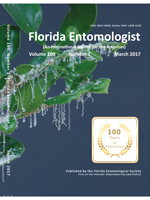Coenosia attenuata Stein (Diptera: Muscidae) is a predatory fly that feeds on other insects and can be used as a potential biological control agent. This insect is native to southern Europe; however, it has been distributed naturally to various continents, including North and South America, and is reported herein for the first time in Mexico. The flies were found preying on whiteflies, psyllids, fungus gnats, leaf miners, and vinegar flies in greenhouses with organic vegetable production.
The family Muscidae (Diptera) is a large group of flies that occupy a great number of ecological niches, and they are found in almost all biogeographic regions. Muscidae possess diverse feeding habits, although most of the species are coprophagous or saprophagous. However, some species are phytophagous or are predators of other arthropods (Huckett & Vockeroth 1987; Carvalho et al. 2005). The subfamily Coenosiinae includes species that are predators in their larval and adult stages. They feed on other insects and can potentially be used as agents for biological control. This is the case for species of the genus Coenosia.
Fig. 1.
Adults and male genitalia of Coenosia attenuata. A) Sexual dimorphism with female on the left, male on the right, B) ventral, lateral, and dorsal views of male genitalia, and C) a female C. attenuata preying on a fungus gnat.

According to Sorokina (2014), 352 species of the genus Coenosia have been described worldwide. Of these, 39 are found in the Neotropical region (Carvalho et al. 2005). In Mexico, however, studies on this genus are practically non-existent. For this reason, we intend to contribute knowledge on the diversity of the Coenosia species that are present in Mexico.
During April 2016, we collected a predator fly that occurs naturally in the municipality of Zapopan, Jalisco (20.79747°N, 103.44381°W), in greenhouses where peppers (Capsicum annuum L.; Solanaceae) are produced organically. Based on the report by Pohl et al. (2012) and the keys for Coenosia species published by Xue & Tong (2003), the species was identified as Coenosia attenuata Stein. This species is commonly called “hunter fly.” Figure 1A shows adults of both sexes. The female is larger and darker than the male. Figure 1B shows different perspectives of the male genitalia as support for identification of the species. The specimens were deposited in the collection at Colegio de Postgraduados, Campus Montecillo (Texcoco, Mexico).
Coenosia attenuata originated in southern Europe (Hennig 1964) and is currently distributed in several countries of Europe, Asia, Africa, and Oceania (Hennig 1964; Pohl et al. 2012). In South America, it has been reported in Peru, Ecuador, Colombia, and Chile (Martínez-Sánchez et al. 2002; Perez 2006; Couri & Salas 2010); in Central America it occurs in Costa Rica (Hernández 2008); and in North America it is found in the United States and Canada (Hoebeke et al. 2003). This report represents the first incidence of Coenosia attenuata in Mexico.
We observed the flies feeding on several adult insect taxonomic groups: whiteflies (Bemisia tabaci Gennadius; Hemiptera: Aleyrodidae), potato-tomato psyllids (Bactericera cockerelli Sulc; Hemiptera: Triozidae), fungus gnats (Diptera: Sciaridae) (Fig. 1C), leaf miners (Lyriomiza sp.; Diptera: Agromyzidae), and vinegar flies (Drosophila sp.; Diptera: Drosophilidae). With the exception of the last of these taxonomic groups, all are or contain major pests of several important crops.
The flies generally land on the upper face of the leaves, on stems, or on structures used to support the pepper plants. Often, they catch their prey in flight. Through observation of their behavior, it appears that this species possesses vision adapted to respond to rapid movements. On occasion, the flies attacked small balls made of pieces of leaf that were dropped near to them.
Growers use yellow traps with an adhesive to capture whiteflies, but they also capture many adults of C. attenuata. If we are to preserve or increase the population of this beneficial species, the impact of this method of whitefly monitoring and control should be evaluated.





